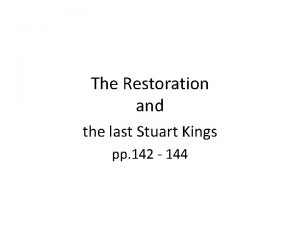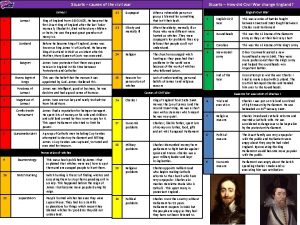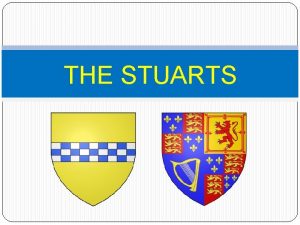The Restoration and the last Stuarts Study Questions



- Slides: 3

The Restoration and the last Stuarts Study Questions Millennium I p. 144

1. • 2. • 3. • 4. • 5. • 6. • • • What does the term Restoration mean in the context of English history? The return of the monarchy. What was Charles II’s first concern? What did he do then? To reassert the predominance of the Church of England. He dissolved the Parliament. What were the two most serious calamities during the Restoration? When did they occur? The Great Plague and the Great Fire of London. They occurred in 1665 and 1666 respectively. Describe James II’s internal policy. He ruled as an absolutist monarch. Unlike his brother Charles, he was Catholic and began to put Catholics in positions of power in every branch of public life. . What does the expression “Glorious” or “Bloodless” Revolution refer to? The bloodless deposition of James II in favour of the crowning of William of Orange and his wife Mary Stuart, James’s protestant daughter. Which laws were passed under the reign of William III? The Bill of Rights (1689), according to which monarchs couldn’t reign without the support of Parliament; the toleration Act (1689), which granted a reasonable amount of religious freedom to Dissenters; the Act of Settlement (1701), which established that within the royal family only Protestants could sit on the throne of England.

7. What Act was passed in 1707 and what did it cause? • The Act of Union, which marked the union of the English and Scottish Parliament. 8. Focus on the War of the Spanish Succession. What did Great Britain gain by it? • Britain entered the war to protect its commercial interests abroad. Holland Prussia sided with her against France, Spain and Portugal. The war ended with the treaty of Utrecht in 1713. • Great Britain. . . 1. retained Gibraltar and Minorca (strategically important for their influence in the Mediterranean), 2. gained the Hudson Bay, Acadia (important for the maritime control of Canada) and the island of Newfoundland. 3. In addition, Britain gained monopoly over the slave market which moved from the coasts of Africa to her own colonies in north America and, finally, . . . 4. had permission to send a ship every year to trade with the Spanish South American colonies. 9. What kind of British trade characterized the Spanish and Portuguese markets ? • Contraband, which had flourished thanks to the prohibition to trade openly. 10. What role did the Bank of England have in foreign policy? • To protect and increase its commercial interest abroad. The government was enabled to support its political enterprises with private capital.





